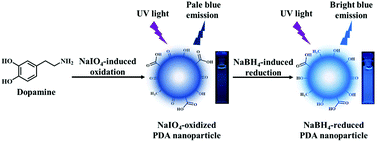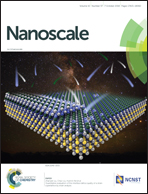Redox modulation of polydopamine surface chemistry: a facile strategy to enhance the intrinsic fluorescence of polydopamine nanoparticles for sensitive and selective detection of Fe3+†
Abstract
In recent years, polydopamine (PDA) nanoparticles have attracted considerable attention in different research fields because of their many fascinating physicochemical properties. However, as an analogue of naturally occurring melanin, PDA nanoparticles (PDANPs) typically exhibit weak fluorescence properties. Herein, we report a facile one-pot method for synthesizing bright blue luminescent PDANPs through the redox modulation of PDA surface chemistry. The composition and morphology of the resultant NPs were systematically characterized by transmission electron microscopy and several spectroscopy methods, which verified the successful fabrication of PDANPs. More importantly, comparative chemical analysis of dopamine polymerization revealed the significant impacts of synthesis conditions and PDA surface chemistry on the luminescence properties of PDANPs. Remarkably, in addition to their excellent water-solubility, salt-tolerance and high photostability under extreme pH conditions, the as-prepared PDANPs possess the highest quantum yield (5.1%) among all the reported intrinsic fluorescent PDANPs. Moreover, based on the coordination interaction between phenolic hydroxyl groups of PDANPs and ferric ions (Fe3+), the synthesized PDANPs were successfully utilized as a turn-off sensing platform for sensitive and selective detection of Fe3+ without using any additional targeting molecules. Upon increasing the Fe3+ concentration in the range from 0.5 to 20 μM, the fluorescence intensity of PDANPs decreased linearly. The detection limit of Fe3+ was 0.15 μM. Finally, this fluorescent sensor was successfully used to determine Fe3+ in natural water samples, showing good prospects for practical applications and may pave the way for the development of new rational methodologies for further enhancing the intrinsic fluorescence of PDA and fabricating other novel fluorescent organic nanoparticles.



 Please wait while we load your content...
Please wait while we load your content...